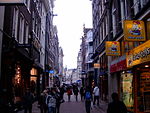Adrian (restaurant)
Defunct restaurants in the NetherlandsMichelin Guide starred restaurants in the NetherlandsPages containing links to subscription-only contentRestaurant stubsRestaurants in Amsterdam ... and 1 more
Use British English from June 2014
Restaurant Adrian is a defunct restaurant in Amsterdam, Netherlands. It was a fine dining restaurant that was awarded one Michelin star in 1967 and retained that rating until 1970.
Excerpt from the Wikipedia article Adrian (restaurant) (License: CC BY-SA 3.0, Authors).Adrian (restaurant)
Singel, Amsterdam Centrum
Geographical coordinates (GPS) Address Nearby Places Show on map
Geographical coordinates (GPS)
| Latitude | Longitude |
|---|---|
| N 52.366641666667 ° | E 4.8907361111111 ° |
Address
Singel 510-3
1017 AX Amsterdam, Centrum
North Holland, Netherlands
Open on Google Maps











